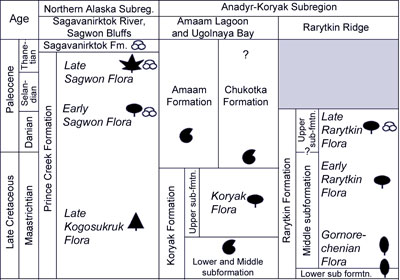Correlations
| North Pacific | AKSR-NASR | Anadyr-Koryak | Verkhoyansk-Chukotka | Okhotsk-Chukotka | N. Alaska | Yukon | Chignik |
|---|---|---|---|---|---|---|---|
| Phytostratigraphy | Images of fossils characteristic of the Type Taphoflora | ||||||
The Late Kogosukruk Phase of Floral EvolutionTaphofloras from assemblages in the upper part of the Kogosukruk Tongue, which is exposed along the Colville River from the Chandler River mouth northward to Ocean Point in the Umiat-Chandler area (Smiley, 1969a), represent the type flora of the Late Kogosukruk phase. The respective plant-bearing deposits are distinguished as Beds with the Late Kogosukruk flora. Their stratigraphic range corresponds to the Campanian–Maastrichtian according to palynological data (Frederiksen and McIntyre, 2000) and partial interfingering with marine deposits of the Sentinel Hill Member of the Schrader Bluff Formation, which are also established to be of this age based on marine fossils (Detterman et al., 1963; Brosgé and Wittington, 1966). The Late Kogosukruk phase lasted approximately 9 – 10 m.y. Plant taxa of the flora are listed in the panel to the right. Distinctive features of the late Kogosukruk flora are its low taxonomic diversity (not more than 13 species), rarity of angiosperm leaves, represented exclusively by aquatic Quereuxia angulata, characteristic reproductive remains Carpolithes sp., and rare, fragmentarily preserved leaf impressions of taxonomically problematic dicots and monocots. Ferns within this flora are represented by the genera Cladophlebis and Arctopteris and conifers by Elatocladus, Parataxodium, Pagiophyllum, Cupressinocladus, and Pityostrobus. Prevailing in the floral assemblages are impressions of Equisetites sp., Parataxodium wigginsii, Carpolithes sp., Quereuxia angulata, and cones belonging presumably to Parataxodium. Megafloral remains of other plants are rare apart from fossilised wood in the from of branchwood and small trunks. The low diversity of fossil plants buried in the Kogosukruk Tongue upper part is not a consequence of inadequate sampling (Spicer, 1990; Spicer and Parrish, 1987, 1990a, 1990b), because they were collected by Spicer and Parrish from approx. 50 locations in different sedimentary facies (alluvial, flood-plain, lacustrine, and palustrine) and so the collections are likely to characterize the actual diversity of preserved plants. The palynological assemblages from the Kogosukruk Tongue (Spicer and Parrish, 1987; Frederiksen and McIntyre, 2000) show that conifers and especially angiosperms identifiable in pollen spectra considerably exceed in diversity the megafossils of both plant groups. Considering this disproportion, Spicer and Parrish (1987, 1990a) concluded that the Campanian–Maastrichtian angiosperms of Northern Alaska were present mostly as herbaceous therophytes whose leaves just occasionally occur in the geological record. In the opinion of Spicer and Parrish, the flora of the Late Kogosukruk phase reflects vegetation dominated by small coniferous trees, with an understorey of ferns of herbaceous angiosperms. The vegetation experienced a cool-temperate climate at its paleolatitude of 82 °N, and was likely similar in appearance to the present-day taiga, or boreal forest. Floras of the Early and Late Kogosukruk phases are similar to some extent. They are both of a low taxonomic diversity and include some species in common: Equisetites sp., Parataxodium wigginsii, Cupressinocladus cretaceus, and Quereuxia angulata. Nevertheless, the Late Kogosukruk flora is less diverse than that of the Early Kogosukruk, particularly the angiosperms. In addition, the Early Kogosukruk flora is comparatively enriched in plant remains characteristic of the Early and mid-Late Cretaceous (Gleichenites ex gr. zippei, Kolymella aff. raevskii, Ginkgo ex gr. adiantoides, Elatocladus sp. cf. Florinia borealis, Elatocladus sp. cf. Cryptomeria subulata, Sequoia fastigiata) and includes platanoid taxa Paraprotophyllum ignatianum, P. cf. ignatianum, Arthollia (?) sp. and Platanaceae gen. et sp. indet., which dominate in some assemblages. The flora of the Late Kogosukruk phase is notably lacking these plant remains. Principal dominants of two floras under comparison are also different: Equisetites sp., Kolymella aff. raevskii, Sequoia fastigiata, Quereuxia angulata, and platanoids dominate in the Early Kogosukruk flora, whereas Equisetites sp., Parataxodium wigginsii, Carpolithes sp., and Quereuxia angulata are the most abundant remains in the Late Kogosukruk flora. Despite this low plant diversity dinosaur remains in the Prince Creek Formation (which includes the Kogosukruk Tongue) are both abundant and taxonomically diverse. For works describing the paleoenviornment of the Late Kogosukruk flora see Flores et al. (2007 a, b), Fiorillo et al. (2015), Flaig et al. (2011; 2013), Flaig and van der Volk (2015), Herman et al. (2016), Phillips (1988; 1990), Spicer and Herman (2010), Suarez et al. (2013; 2015), van der Kolk et al. (2015). The Gornorechenian and Koryak floras of the Anadyr–Koryak Subregion can be regarded as coeval with the late Kogosukruk flora despite the obvious difference in taxonomic composition and physiognomic appearance.
|
|
|||
 |
Correlation chart showing the relationships between the Late Kogosukruk flora and those in northeastern Russia. |
|||

